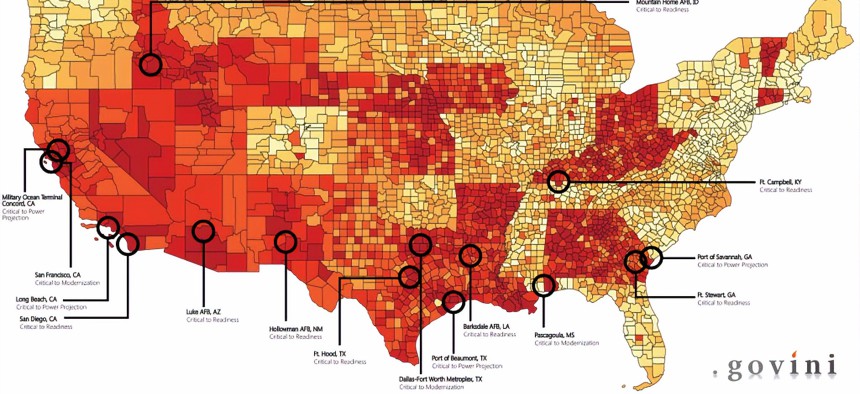
This map generated by data analysis firm Govini show military hubs expected to be hit hardest by the coronavirus. Govini
Coronavirus Is Rising Around US Military, Defense Infrastructure, Analysis Shows
The Govini assessment indicates that COVID-19 is about to hit military bases and manufacturing hubs in the southern and western United States.
The coronavirus will deal a major blow to U.S. military readiness in coming weeks as it spreads to bases and manufacturing hubs in the southern and western parts of the country, a new analysis by data and analytics firm Govini predicts.
Govini analysts say the forecast could help Pentagon leaders and local commanders better prepare, and help military decision makers allocate some $10 billion in virus aid approved by Congress as part of a sweeping $2 trillion stimulus package last week.
“I'm convinced that if they don't apply data and decision science to this mission and this problem set, in the best case scenario, the funding risks being inefficiently allocated,” said Govini’s CEO, Tara Murphy Dougherty, whose firm uses data science and machine learning to analyze national security data.
“Decision makers lack good, accurate, real-time information unless they take advantage of things like these,” Dougherty said. “In the worst situation, it gets squandered and too much money goes toward areas that don't really need it and not enough goes toward the things that are really critical.”
The Govini risk assessment draws on three numbers from every U.S. county: available hospital beds, COVID-19 tests being conducted, and confirmed cases.
“This is what we need to be thinking of in terms of what's coming next,” Dougherty said.
A map generated by the Govini analysis shows giant red swaths indicating “high-risk” areas covering almost half of the country. For the next 14 days, it covers California, Nevada, Arizona, New Mexico, Wyoming, Louisiana, Arkansas, Georgia, Kentucky, West Virginia, Ohio, Idaho, and large portions of Kansas, Nebraska, and Texas.
The area includes many bases that house troops and weapons that would be essential in wars against Russia and China — preparations for which are prioritized by the 2018 National Defense Strategy. So are warplane and missile assembly lines and the coastal shipyards and ports that transport weapons to forces overseas.
“We took activities happening at these bases and installations,” Dougherty said. “We basically categorize them into examples where there's an impact on readiness, an example of where there's an impact on power projection capabilities, and then examples of where there's an impact on modernization.”
The military relies on contractors for much of its base operations, including training.
“When you think of things like training forces and conducting maintenance and deployment functions and things like that, if everyone is consumed with the virus and falls in the infected category or is out of completely out of commission not just teleworking, then [there’s a] major readiness impact there,” Dougherty said.




